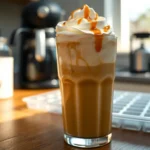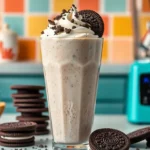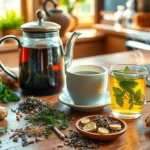We’ve all been there – craving a perfect cup of tea but without access to a kettle or stovetop. Making tea in the microwave might sound unconventional, but it’s actually a quick and efficient method that millions of people use daily. Whether you’re in a dorm room, office, or simply want the fastest route to your caffeine fix, microwaving tea can deliver surprisingly excellent results.
The key lies in understanding the proper technique and timing. Unlike traditional brewing methods, microwave tea preparation requires exact steps to ensure optimal flavor extraction without overheating or creating uneven temperatures. We’ll show you exactly how to achieve that perfect balance.
Microwave tea brewing isn’t just convenient – it’s also incredibly versatile. You can customize water temperature for different tea types, control steeping time precisely, and even experiment with unique flavor combinations. Ready to master this modern brewing method?
Equipment Needed
Making tea in the microwave requires minimal equipment that most households already have on hand. We’ve compiled this essential list to ensure your microwave tea brewing experience goes smoothly.
Essential Items:
- Microwave-safe mug or cup – Choose ceramic or glass containers that can withstand microwave heating
- Microwave oven – Any standard microwave will work for this brewing method
- Measuring cup or spoons – For accurate water measurements and precise brewing
- Tea bags or loose leaf tea – Your preferred tea variety for optimal flavor
- Clean water – Fresh filtered or tap water works best for brewing
Optional but Helpful Equipment:
- Microwave-safe stirring spoon – Wooden or plastic spoons prevent scratching and are safe for microwave use
- Small plate or microwave cover – Prevents splattering during the heating process
- Tea strainer – Essential when using loose leaf tea varieties
- Timer or smartphone – Ensures precise timing for perfect steeping
- Oven mitts or kitchen towel – Protects hands when handling hot containers
We recommend checking that all containers are labeled as microwave-safe before use. Glass and ceramic mugs work exceptionally well because they heat evenly and retain temperature effectively. Avoid metal containers entirely as they can cause dangerous sparking in the microwave.
The beauty of microwave tea brewing lies in its simplicity. Most equipment needed is already available in your kitchen. This makes the method particularly appealing for office workers, students, or anyone seeking a quick brewing solution without specialized tea equipment.
Ingredients

Making tea in the microwave requires just a few simple ingredients that you likely already have in your kitchen. We’ll walk through the essential components needed for this convenient brewing method.
Basic Microwave Tea Ingredients
For Hot Tea:
- 1 tea bag or 1 teaspoon loose leaf tea
- 6-8 ounces clean filtered water
- Optional: sweetener or milk to taste
For Iced Tea:
- 5 black tea bags
- 1 quart (4 cups) clean filtered water
- Sugar or sweetener (optional)
- Ice cubes for serving
For Green Tea Variation:
- 1 teaspoon Japanese sencha green tea or 1 green tea bag
- 6-8 ounces cold filtered water
Water Quality Considerations
| Water Type | Best Use | Notes |
|---|---|---|
| Filtered water | All tea types | Removes chlorine and impurities |
| Tap water | Basic brewing | May affect flavor in hard water areas |
| Distilled water | Delicate teas | Can taste flat but won’t interfere with tea flavor |
The quality of water significantly impacts your tea’s final taste. We recommend using filtered water whenever possible to ensure the purest flavor extraction. Cold water works best for green tea preparation while room temperature water suits most other tea varieties.
Fresh tea bags or loose leaf tea provide the most robust flavor profiles. Store your tea in a cool dry place away from direct sunlight to maintain optimal freshness. Replace tea bags every 18-24 months and loose leaf tea within 2-3 years for the best brewing results.
Instructions

We’ll guide you through the simple process of brewing perfect tea using your microwave. Our step-by-step method ensures optimal flavor extraction while maintaining safety throughout the process.
Prep the Mug and Water
We start by selecting a microwave-safe mug that can withstand high temperatures without cracking or breaking. Our recommended approach involves filling the mug with clean water to about 1-2 inches deep, depending on your desired tea strength. The water depth directly affects the final concentration, so we suggest starting with less water for stronger tea and more for a milder brew.
Microwave the Water
We place the prepared mug carefully in the center of our microwave for even heating. Our heating method requires 1 to 1.5 minutes of microwave time, though this varies based on your microwave’s power level. Higher wattage microwaves may require less time, while lower power units need the full duration for proper water temperature.
Add the Tea
We remove the hot mug from the microwave with extreme caution to avoid burns from the heated ceramic. Our tea addition process involves adding one tea bag or one teaspoon of loose-leaf tea immediately to the hot water. The timing matters here since we want the water at its optimal temperature for flavor extraction.
Steep the Tea
We allow the tea to steep for exactly 3 minutes to achieve proper flavor infusion without over-extraction. Our steeping timeline ensures that the tea releases its beneficial compounds and develops full flavor profiles. We then remove and discard the tea bag or strain loose-leaf tea to prevent unwanted bitterness from prolonged contact.
Final Touches
We enhance our brewed tea by adding desired sweeteners such as sugar, honey, or artificial alternatives according to personal taste preferences. Our finishing technique includes thorough stirring to distribute all added ingredients evenly throughout the tea. Additional flavorings like lemon juice, milk, or spices can be incorporated at this stage for customized taste profiles.
Safety Tips for Microwaving Water

Microwaving water requires careful attention to prevent accidents and ensure optimal results. We must prioritize safety measures to avoid burns and other hazards during the heating process.
Prevent Superheating Risks
Superheating poses the most important danger when microwaving water. This phenomenon occurs when water reaches temperatures beyond boiling without forming visible bubbles. We recommend placing a microwave-safe wooden stir stick or spoon in the cup during heating to prevent this dangerous condition. The non-metal object creates nucleation sites that allow normal bubbling to occur.
Use Proper Protective Equipment
Always handle hot containers with appropriate protection. We suggest using oven mitts or a thick towel when removing heated cups from the microwave. This simple precaution prevents burns from unexpectedly hot surfaces that may not appear dangerous.
Monitor Container Fill Levels
Never overfill your microwave-safe container when heating water. We recommend filling cups only halfway to two-thirds full to prevent dangerous spills. This spacing allows for proper heat circulation and reduces the risk of scalding liquid overflow.
Verify Microwave Safety Standards
All containers and utensils must carry microwave-safe labels before use. We emphasize checking these certifications to prevent container damage or chemical leaching. Glass and ceramic containers typically provide the safest options for heating water.
Adjust Timing Based on Equipment
Microwave wattage affects heating times significantly. We advise monitoring your exact appliance’s performance and adjusting timing accordingly. Standard heating ranges from 1-2 minutes for single servings, but higher wattage units may require shorter periods to prevent overheating.
| Water Amount | Heating Time | Power Level |
|---|---|---|
| 8-12 oz (240-350 ml) | 1-2 minutes | High |
| 1 quart (1 liter) | 8-10 minutes | High |
Handle Containers with Extra Care
Hot water containers can cause severe burns even when they appear manageable. We recommend allowing containers to cool briefly before handling and always maintaining a secure grip when moving heated items from the microwave.
Best Practices for Microwave Tea

Following these proven techniques will transform your microwave tea brewing from basic to exceptional. We’ve gathered the most effective practices to ensure consistent results every time.
Choosing the Right Mug
We recommend selecting a microwave-safe mug as your first priority to avoid the risk of breakage or chemical release. Ceramic and glass mugs work exceptionally well for microwave tea preparation. Avoid metal containers or mugs with metallic trim since these can create dangerous sparks in the microwave. The ideal mug should have a wide opening to allow proper heat distribution and easy tea bag removal. We suggest choosing a mug with a comfortable handle that stays cool during the heating process.
Water Temperature Guidelines
Most teas achieve optimal flavor when we heat water in the microwave for 1-2 minutes on high power depending on the desired strength. The heating duration varies based on your microwave’s wattage and the amount of water used. We find that starting with 1 minute works well for single servings and adjusting from there produces the best results. Different tea types require exact temperature ranges for maximum flavor extraction. Green teas perform best with slightly cooler water while black teas benefit from hotter temperatures.
| Tea Type | Heating Time | Water Temperature |
|---|---|---|
| Green Tea | 1-1.5 minutes | 160-180°F |
| Black Tea | 1.5-2 minutes | 190-212°F |
| Herbal Tea | 1.5-2 minutes | 190-212°F |
| White Tea | 1-1.5 minutes | 160-185°F |
Steeping Time Recommendations
We allow the tea to steep for 1-3 minutes depending on the type of tea and personal preference for optimal flavor development. Black teas typically require the full 3 minutes to release their robust flavors completely. Green and white teas achieve their best taste profile with shorter steeping times of 1-2 minutes. Herbal teas can steep longer without becoming bitter since they contain no tannins. We recommend starting with shorter steeping times and gradually increasing until you find your preferred strength. Over-steeping can result in bitter or astringent flavors that mask the tea’s natural characteristics.
Troubleshooting Common Issues

Even with careful preparation microwave tea brewing can present unexpected challenges. We address the most common problems and provide practical answers to ensure perfect results every time.
Preventing Superheated Water
Superheated water poses the most serious risk when making tea in the microwave. We recommend placing a wooden stirring stick or microwave-safe object in the mug before heating to create nucleation sites. This simple step prevents water from reaching temperatures above boiling point without actually bubbling.
Stirring the water gently before heating creates small disturbances that help prevent superheating conditions. We always suggest using this technique as an additional safety measure. Never add tea bags or loose tea to extremely hot water immediately after microwaving since this can cause sudden violent bubbling.
Fixing Over-Steeped Tea
Over-steeped tea develops an unpleasant bitter taste that can ruin your brewing experience. We solve this problem by removing tea bags or straining loose leaf tea immediately when the steeping timer reaches the recommended time. Black teas should never steep longer than 5 minutes while green and white teas require removal after 3 minutes maximum.
Adding a small amount of cold water can dilute overly strong tea and reduce bitterness. We recommend starting with one tablespoon of cold water and tasting before adding more. Honey or sugar can also mask some bitterness but prevention remains the best approach.
Adjusting Strength and Flavor
Tea strength depends on both heating time and steeping duration rather than just one factor. We increase heating time by 15-30 seconds for stronger tea base while maintaining the same steeping period. Conversely reducing heating time by similar intervals creates milder tea without compromising flavor extraction.
Multiple tea bags in the same mug provide another method for strength adjustment. We use two tea bags for robust breakfast blends or when serving larger portions. Loose leaf tea quantities can be adjusted from one teaspoon to one and a half teaspoons per cup depending on desired intensity.
Water temperature variation affects different tea types significantly. We heat water for 90 seconds for delicate green teas and extend to 2 minutes for robust black varieties. Testing different combinations of heating and steeping times helps identify your personal preference profile.
Storage and Make-Ahead Tips

Storing your freshly brewed microwave tea properly ensures optimal flavor retention and convenience for future enjoyment. We recommend consuming your tea within 24 hours of brewing for the best taste experience. Freshly brewed tea maintains its peak flavor profile when stored in the refrigerator immediately after cooling to room temperature.
Proper Storage Methods
Place your cooled tea in an airtight container or covered pitcher before refrigerating. Glass containers work exceptionally well for maintaining tea quality without absorbing flavors or odors. We suggest avoiding plastic containers for extended storage as they can impact the tea’s natural taste over time.
Label your stored tea with the brewing date to track freshness effectively. Different tea varieties maintain their quality for varying periods, with black teas typically lasting longer than delicate green or white teas when refrigerated.
Make-Ahead Brewing Strategies
Prepare large batches of tea using the microwave method to save time throughout the week. For bulk preparation, we use 3 tea bags in 8 cups of water and microwave for 3 minutes and 33 seconds. This approach provides enough tea for multiple servings while maintaining consistent flavor.
Dunk the tea bags several times during the steeping process to ensure even flavor extraction across the entire batch. Remove all tea bags promptly after steeping to prevent over-extraction and bitterness.
Flavor Enhancement Before Storage
Add your preferred sweeteners, lemon juice, or herbs while the tea is still warm for better dissolution and flavor integration. Sugar dissolves more effectively in warm tea, creating a more uniform sweetness throughout the batch. Fresh lemon juice adds brightness and helps preserve the tea’s natural antioxidants during storage.
Store flavored and unflavored teas separately to maintain distinct taste profiles. This separation allows you to customize individual servings according to preference while keeping the base tea neutral for versatility.
Conclusion
We’ve shown you that making tea in the microwave isn’t just possible—it’s actually a convenient and effective brewing method when done correctly. With the right technique and safety precautions you can create perfectly steeped tea that rivals traditional brewing methods.
The key to success lies in understanding your microwave’s power settings using proper steeping times and maintaining safety throughout the process. Whether you’re brewing a quick cup at the office or preparing tea for later we’ve equipped you with all the knowledge you need.
Remember that practice makes perfect so don’t hesitate to experiment with different tea types and adjust timing to suit your taste preferences. Your microwave can become a reliable tea-making companion once you master these simple techniques.
Frequently Asked Questions
Can you really make good tea in the microwave?
Yes, you can make excellent tea in the microwave with proper technique. The key is using the right timing, water temperature, and steeping duration. Microwave brewing offers precise control over these variables, allowing for customization based on tea type. While unconventional, this method is convenient and efficient, especially for office workers and students without traditional brewing equipment.
What equipment do I need for microwave tea brewing?
Essential items include a microwave-safe mug or cup, microwave oven, measuring tools, tea bags or loose leaf tea, and clean water. Optional equipment includes a stirring spoon, small plate cover, tea strainer, timer, and oven mitts. The simplicity of required equipment makes this method accessible to anyone with basic kitchen supplies.
How long should I microwave water for tea?
Microwave water for 1 to 1.5 minutes for optimal temperature. Heating time may vary based on your microwave’s wattage and desired tea strength. For stronger tea, heat for up to 2 minutes. Always use a microwave-safe container and avoid overheating to prevent superheating, which can be dangerous.
What’s the proper steeping time for microwave tea?
Black teas should steep for exactly 3 minutes for optimal flavor extraction. Green and white teas require shorter steeping times to avoid bitterness. After microwaving the water, add your tea and let it steep for the recommended duration. Remove tea bags or strain loose leaf tea immediately after steeping to prevent over-extraction.
How do I prevent water from superheating in the microwave?
Use a wooden stir stick or non-metal object in the water while heating to prevent superheating. Stir the water gently before and after heating. Never overfill containers, and always use microwave-safe mugs or cups. Wear oven mitts when handling hot containers, and allow the water to cool slightly before adding tea.
What type of mug is best for microwave tea brewing?
Ceramic or glass mugs work best for microwave tea brewing. Avoid metal containers completely as they’re not microwave-safe and can cause sparks. Ensure your chosen mug is labeled as microwave-safe. The container should be appropriately sized to prevent overflow and allow room for tea bag movement during steeping.
Can I make multiple cups of tea at once in the microwave?
Yes, you can prepare bulk tea using 3 tea bags in 8 cups of water. Microwave for approximately 3 minutes and 33 seconds, then dunk tea bags during steeping for even flavor extraction. This method is efficient for meal prep or serving multiple people. Always use appropriately sized microwave-safe containers.
How should I store leftover microwave-brewed tea?
Consume brewed tea within 24 hours for optimal flavor. Store cooled tea in airtight glass containers in the refrigerator, labeled with the brewing date. Add sweeteners while tea is warm for better integration. Store flavored and unflavored teas separately to maintain distinct taste profiles and prevent flavor contamination.
What water should I use for the best microwave tea?
Filtered water produces the best flavor extraction and tea quality. While tap water is acceptable, filtered water removes chlorine and impurities that can affect taste. Avoid distilled water as it lacks minerals that enhance tea flavor. Fresh, clean water is essential regardless of the source you choose for brewing.
How do I fix over-steeped or bitter tea?
Remove tea bags or strain loose leaf tea immediately when bitterness occurs. For future brewing, reduce steeping time or use fewer tea bags. You can dilute over-steeped tea with additional hot water. Adjust brewing parameters by modifying heating times and tea quantity to achieve your preferred strength and flavor profile.







